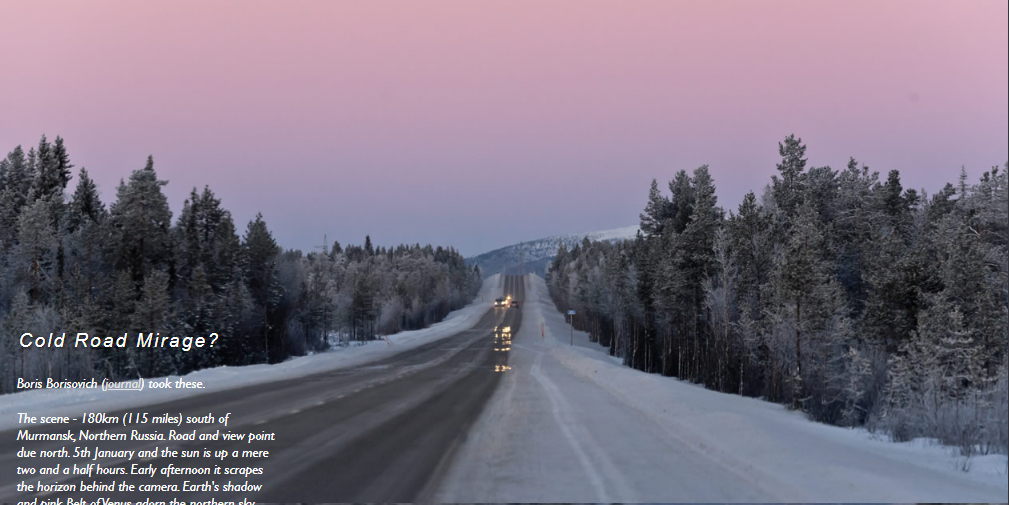Cold Road Mirage, Northern Russia
Cold Road Mirage: An Arctic Optical Phenomenon in Northern Russia
In the remote regions of Northern Russia, an intriguing atmospheric optics phenomenon known as the "Cold Road Mirage" captivates observers. On a frosty day in January, Boris Borisovich, a keen observer and photographer, captured a series of mesmerizing images showcasing this peculiar occurrence. The photographs were taken approximately 180km (115 miles) south of Murmansk, where the road stretches northward, offering a stunning vantage point. The images reveal a remarkable interplay of light and air, displaying reflections below the distant car headlights.
Typically, we associate such reflections with undulating roads heated by the scorching summer sun. The hot surface warms the air in contact, creating layers of warm air beneath the cooler air. This temperature gradient gives rise to an inferior mirage, where rays from a car or the sky refract across the layers and bend back upwards, forming one or more false images beneath the real objects. However, the mystery deepens when we consider that these reflections occur in frigid temperatures as low as -30 degrees Celsius and with minimal sunlight to warm the road.
One plausible explanation for the Cold Road Mirage is the presence of strips of smooth reflective ice across the road. These icy patches could potentially create the reflections rather than a traditional mirage. However, questions arise regarding the durability of such ice strips under regular traffic conditions. Upon closer inspection of one of the images captured at a different location, the bands closely resemble rippling air and a miraged sky, rather than solid ice patches. This observation suggests that there may be other factors at play.
The enigmatic nature of Arctic light and air can often deceive our senses, creating optical illusions that defy explanation. In the case of the Cold Road Mirage, it is possible that the lower layers of air are unexpectedly warmer than the surrounding atmosphere. Several factors could contribute to this phenomenon, including the elevation of the road itself and the proximity of the frozen White Sea. These elements may create localized temperature variations, leading to the formation of the captivating reflections observed in the photographs.
The Arctic region is renowned for its stunning natural beauty and its propensity to surprise and intrigue observers. The Cold Road Mirage serves as a reminder of the complex interplay between light, air, and temperature in this remote corner of the world. As we continue to explore and study atmospheric optics phenomena, such as this unique mirage, we gain a deeper understanding of the intricate mechanisms that shape our perception of the natural world.
In conclusion, the Cold Road Mirage in Northern Russia showcases the mesmerizing effects of temperature differentials on light propagation. While traditional mirages are commonly associated with scorching heat, this phenomenon challenges our expectations by occurring in freezing temperatures. Through the lens of Boris Borisovich's camera, we catch a glimpse of the mysterious interplay between reflective ice, warm air layers, and Arctic light that gives rise to this captivating optical display. The Cold Road Mirage stands as a testament to the wondrous and unpredictable nature of our atmosphere, reminding us of the limitless beauty that surrounds us.

Cold Road Mirage?
Boris Borisovich (journal) took these.
The scene - 180km (115 miles) south of Murmansk, Northern Russia. Road and view point due north. 5th January and the sun is up a mere two and a half hours. Early afternoon it scrapes the horizon behind the camera. Earth's shadow and pink Belt of Venus adorn the northern sky.

Temperature -30 Celsius.
There are several "reflections" below the distant car headlights. We see them in summer along undulating roads heated by blazing sunshine. The hot surface heats air in contact forming layered warm air beneath cooler. The stuff of an inferior mirage. Rays from a car or the sky refract across the temperature gradients and bend back upwards. They form one or more images beneath the real objects.
But at -30 and with little sun to warm the road?
A tempting explanation is that strips of smooth reflective ice across the road give the reflections rather than a mirage. Would they survive the regular traffic? The third image below at a different location shows the bands close up. They more resemble rippling air and a miraged sky.
Somehow the lower air is warmer. Perhaps the road elevation helps. Perhaps the nearness of the frozen White Sea.
Arctic light and air play tricks, deceive . .
Image ©Boris Borisovich, shown with permission

Note: this article has been automatically converted from the old site and may not appear as intended. You can find the original article here.
Reference Atmospheric Optics
If you use any of the definitions, information, or data presented on Atmospheric Optics, please copy the link or reference below to properly credit us as the reference source. Thank you!
-
<a href="https://atoptics.co.uk/blog/cold-road-mirage-northern-russia/">Cold Road Mirage, Northern Russia </a>
-
"Cold Road Mirage, Northern Russia ". Atmospheric Optics. Accessed on November 22, 2024. https://atoptics.co.uk/blog/cold-road-mirage-northern-russia/.
-
"Cold Road Mirage, Northern Russia ". Atmospheric Optics, https://atoptics.co.uk/blog/cold-road-mirage-northern-russia/. Accessed 22 November, 2024
-
Cold Road Mirage, Northern Russia . Atmospheric Optics. Retrieved from https://atoptics.co.uk/blog/cold-road-mirage-northern-russia/.